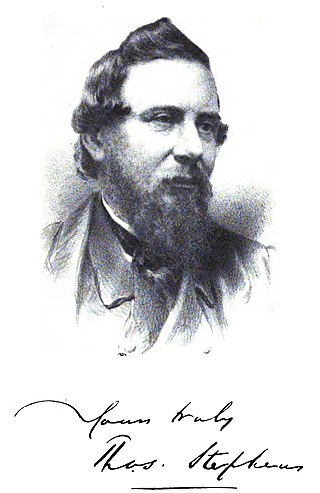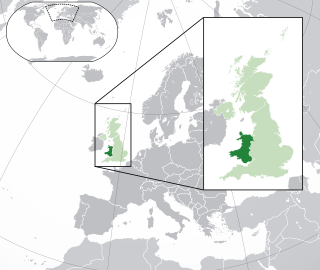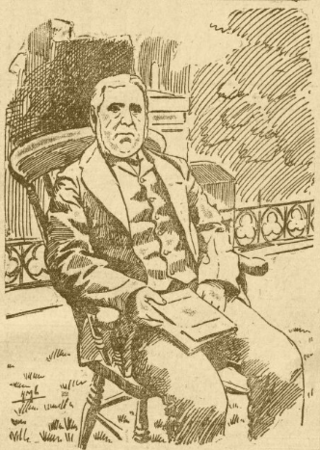
David Alfred Thomas, 1st Viscount Rhondda, PC, was a Welsh industrialist and Liberal politician. He was UK Member of Parliament (MP) for Merthyr Tydfil from 1888 until the January 1910 general election, then MP for Cardiff until the December 1910 general election, when he left politics to concentrate on his business interests. He was made a member of the Privy Council in 1916. He later held office, notably as "Food Controller" in Lloyd George's wartime coalition government.

Thomas Stephens was a Welsh historian, literary critic, and social reformer. His works include The Literature of the Kymry (1849,1876), Madoc: An Essay on the Discovery of America by Madoc ap Owen Gwynedd in the Twelfth Century (1858,1893), and Orgraff yr Iaith Gymraeg (1859), as well as a number of prize-winning essays presented at eisteddfodau between 1840 and 1858. He was the first Welsh historian and literary critic to employ rigorous scientific methods, and is considered to have done more to raise the standards of the National Eisteddfod than any other Welshman of his time. Stephens also figured prominently in efforts to implement social, educational and sanitary reforms both locally in Merthyr Tydfil and more broadly throughout Wales.

The media in Wales provide services in both English and Welsh, and play a role in modern Welsh culture. BBC Wales began broadcasting in 1923 have helped to promote a form of standardised spoken Welsh, and one historian has argued that the concept of Wales as a single national entity owes much to modern broadcasting. The national broadcasters are based in the capital, Cardiff.
This article is about the particular significance of the year 1882 to Wales and its people.
This article is about the particular significance of the year 1868 to Wales and its people.

Joseph Edwards was a Welsh sculptor. His work appears in many churches and cemeteries in England and Wales, in Westminster Abbey, and in the old town hall of Merthyr Tydfil. Seventy of his works were exhibited at the Royal Academy of Arts between 1838 and 1878.

The history of the Jews in Wales begins in the 13th century. However, shortly after the English conquest of Wales, Edward I issued the 1290 Edict of Expulsion expelling the Jews from England. From then until the formal return of the Jews to England in 1655, there is only one mention of Jews on Welsh soil.

Archaeologia Cambrensis is a Welsh archaeological and historical scholarly journal published annually by the Cambrian Archaeological Association. It contains historical essays, excavation reports, and book reviews, as well as society notes and accounts of field visits. The journal has included "much valuable material on the manuscripts, genealogy, heraldry, toponymy, folklore and literature of Wales".
Osborn Wyddel the Irishman, , was founder of the houses of Cors y gedol, Wynne of Ynys maengwyn, Wynne of Maes y neuadd, and other important families in Merionethshire.
The Bells of Aberdovey is a popular song which refers to the village now usually known locally by its Welsh-language name of Aberdyfi in Gwynedd, Wales at the mouth of the River Dyfi on Cardigan Bay. The song is based on the legend of Cantre'r Gwaelod, which is also called Cantref Gwaelod or Cantref y Gwaelod. This ancient sunken kingdom is said to have occupied a tract of fertile land lying between Ramsey Island and Bardsey Island in what is now Cardigan Bay to the west of Wales. The legend supposes that the bells of the submerged lost kingdom can be heard ringing below the waves on the beach at Aberdyfi.
Lucy Thomas was a Welsh businesswoman and colliery owner known as the "mother of the Welsh steam coal trade". Thomas took over the running of her husband Robert's coal mine after his death in 1833. Unusual as it was at the time that a woman ran the business, more unusually she was also illiterate. Business documents held in the Glamorgan Archives show she signed only with an X. Much of Thomas' subsequent success as a businesswoman was embellished by Merthyr historian Charles Wilkins, who wrote one of the few articles on her life. It is now believed that George Insole, a Cardiff agent, was one of the chief architects of her success, though this does not diminish Thomas's position as one of the few women coal owners in industrial Britain. It is recorded that Lucy once attended the Coal Exchange in Cardiff only to be told she could not enter. She sent a male clerk in her employ into the Coal Exchange with a letter informing the establishment that "My coal is equal to any mans, failure to grant entry will lead to my business lining another's pockets."

John Rowlands was a Welsh antiquary and educator, a literary man who wrote several interesting things in English and Welsh, and was an occasional contributor to the daily and weekly journals of the day.

Barnett Samuel Marks R.C.A. was a Welsh-Jewish portrait painter who was also noted for his social realism paintings.

Charles Wilkins of Merthyr Tydfil, Glamorganshire, was a prolific writer of historical accounts of Wales and its industries. He produced pioneering reference works on the histories of Merthyr Tydfil and Newport; the coal, iron, and steel trades of South Wales; and Welsh literature. He was also founding editor of The Red Dragon: The National Magazine of Wales.

The Cambrian Quarterly Magazine and Celtic Repertory was an English-language quarterly magazine that published articles on Welsh and Celtic history and literature. Its aims were "to preserve 'native lore' for posterity and to win 'the incurious and indifferent into an interest for Wales'." It ran from 1829 to 1833.
The Cambrian Miners' Association, also known as the Rhondda District Miners' Association, was an early trade union representing coal miners in the Rhondda Valley, in Wales.
The Aberdare, Merthyr and Dowlais Miners' Association was a trade union representing coal miners in part of Glamorgan in South Wales.

George Insole was an English entrepreneur who built an extensive coal mining and shipping business in South Wales.











